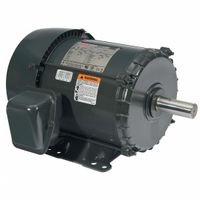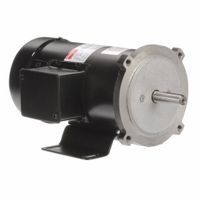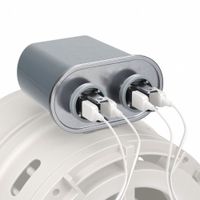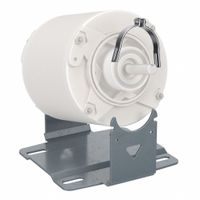Call +(254) 703 030 000 / 751 483 999 / 721 704 777
- Home
- Motors
.....Read More
Frequently Asked Questions
What are the different types of motors?
Motors convert electrical energy into mechanical energy. They are broadly categorized into AC (Alternating Current) and DC (Direct Current) motors. AC motors include induction motors (squirrel cage and wound rotor) and synchronous motors, widely used in industrial applications due to their efficiency and reliability. DC motors, such as brushed (series, shunt, and compound) and brushless DC (BLDC) motors, offer excellent speed control and are common in automotive, robotics, and smaller electronics. Other types include stepper motors for precise positioning, and servo motors for high-performance motion control, often found in automation and robotics.
How does an electric motor work?
An electric motor converts electrical energy into mechanical energy. It operates on the principle of electromagnetism, where the interaction between magnetic fields generates motion. When an electric current flows through a coil of wire (the rotor) placed within a stationary magnetic field (from magnets or electromagnets in the stator), it creates an opposing magnetic field. This interaction produces a force, known as torque, which causes the rotor to spin. Commutators and brushes in DC motors, or alternating current in AC motors, continuously reverse the direction of the current in the coil, ensuring continuous rotation in one direction.
What is the difference between AC and DC motors?
AC (Alternating Current) motors are powered by alternating current, which periodically reverses direction. This makes them ideal for applications requiring variable speed and power, commonly found in industrial machinery, appliances, and electric vehicles. DC (Direct Current) motors, conversely, operate on direct current, which flows in one constant direction. They offer precise speed control and high torque at low speeds, making them suitable for applications like robotics, power tools, and electric trains. The primary distinction lies in the type of electrical current they utilize and their resulting performance characteristics.
How do I choose the right motor for my project?
Choosing the right motor depends on your project's specific needs. Consider factors like torque, speed, voltage, and current requirements. Determine if you need continuous or intermittent operation, and if precise control is essential. Brushed DC motors are simple and cost-effective for basic applications, while brushless DC (BLDC) motors offer higher efficiency and longevity. Stepper motors are ideal for precise positioning, and servo motors provide closed-loop control for accuracy. Evaluate the size and weight constraints, as well as the power source available. Research data sheets and consider consulting with experts for complex projects to ensure optimal performance and safety.
What are the common causes of motor failure?
Common causes of motor failure include electrical issues like voltage imbalances, overcurrent, and power surges, which can damage windings and insulation. Mechanical problems such as bearing wear, misalignment, and vibration lead to increased friction and heat. Environmental factors like excessive heat, moisture, and contamination can degrade motor components. Additionally, inadequate lubrication, improper installation, and lack of regular maintenance also contribute significantly to premature motor failure. Addressing these issues through proper selection, installation, and preventive maintenance is crucial for extending motor lifespan.
How can I improve the efficiency of a motor?
Improving motor efficiency involves several strategies. Regular maintenance, including cleaning and lubrication, reduces friction and energy loss. Ensuring proper motor sizing for the application prevents inefficiency from under or overloading. Utilizing variable frequency drives (VFDs) allows the motor speed to be adjusted to the exact demand, saving energy when full power isn't needed. Upgrading to higher efficiency motors, such as IE3 or IE4 rated models, can significantly cut energy consumption. Additionally, optimizing power factor correction can reduce reactive power, further enhancing overall system efficiency.
What is the lifespan of a typical motor?
The lifespan of a typical motor varies significantly based on its type, application, operating conditions, and maintenance. For instance, well-maintained industrial motors can last for decades, often exceeding 20 years, especially if they are regularly serviced, lubricated, and operated within their specified parameters. Smaller, consumer-grade motors, found in appliances, might have a shorter lifespan, ranging from a few years to 10-15 years, due to less robust construction or less frequent maintenance. Factors like heat, vibration, and electrical stress can drastically reduce a motor's operational life if not managed properly.
How do I troubleshoot motor problems?
Troubleshooting motor problems often involves a systematic approach. Begin by checking the power supply to ensure proper voltage and current. Inspect all connections for looseness or corrosion. Listen for unusual noises, which can indicate issues like bearing wear or misalignment. Feel the motor for excessive heat, a sign of overload or insufficient ventilation. Examine the motor's windings for any visible damage or signs of burning. If the motor has a capacitor, test its capacitance. For more complex issues, consider the motor's age and operating conditions. Consulting the motor's manual or a qualified technician is recommended for persistent problems.
What are the different type of motors?
Motors convert electrical energy into mechanical energy, and they come in various types. DC motors, powered by direct current, include brushed and brushless variations, often used in applications requiring variable speed. AC motors, powered by alternating current, are common in industrial settings and home appliances; examples include induction motors and synchronous motors. Stepper motors provide precise positional control, ideal for robotics and 3D printers. Servo motors offer high accuracy and torque, used in automation and manufacturing. Specialized motors like linear motors and gearmotors also exist, each designed for specific applications based on their unique operating principles and performance characteristics.
How much does a motor cost?
The cost of a motor can vary significantly depending on several factors, including the type of motor (e.g., AC, DC, servo, stepper), its power rating (horsepower or wattage), efficiency, brand, and additional features. A small, basic motor for a hobby project might cost less than $20, while an industrial-grade motor for heavy machinery could range from hundreds to thousands of dollars, or even more for highly specialized applications. Factors like custom specifications, quantity purchased, and global market conditions also play a role in the final price.






